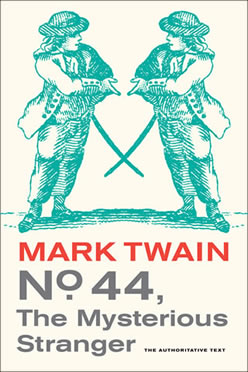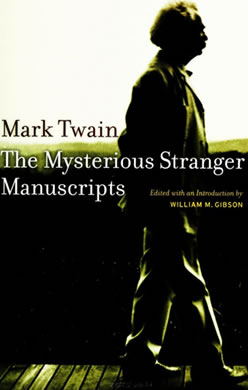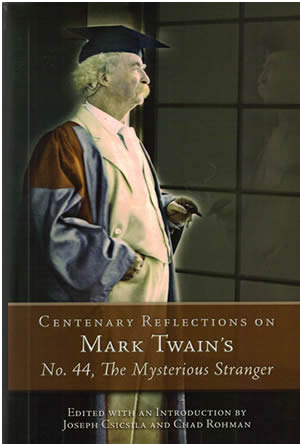

MARK TWAIN &
|
 Available from amazon.com |
In 1916, six years after Mark Twain's death, his biographer and literary executor Albert Bigelow Paine released a book titled THE MYSTERIOUS STRANGER, claiming it was Mark Twain's last major work. The book has now passed into public domain and remains widely available. In 1963 scholars, led by researcher John S. Tuckey, carefully examined Twain's papers and manuscripts and discovered that Paine had tampered with and patched together three previously unfinished manuscripts and with assistance from Frederick Duneka added passages not written by Mark Twain in order to complete the THE MYSTERIOUS STRANGER. Paine's volume was a literary fraud that went undetected for more than forty years.
In 1969 the University of California Press published all Twain's unfinished manuscripts for the story in a scholarly edition titled MARK TWAIN'S MYSTERIOUS STRANGER MANUSCRIPTS edited by William M. Gibson.
 Available from amazon, this book contains all the versions of Twain's story along with his working notes. |
Four versions of the "Mysterious Stranger" story exist in three manuscripts. These are identified as:
|
The final version of the story NO. 44, THE MYSTERIOUS STRANGER was released in a popular edition by University of California Press in 1982.
The name No. 44 for young Satan was one Twain had first used in the unfinished "Schoolhouse Hill" version:
|
"My wonderful scholar, tell me your name." The school crowded forward in a body to devour the stranger at close quarters with their envying eyes; all except Bascom, who remained apart and sulked. "Quarante-quatre, sir. Forty-four." "Why--why--that is only a number, you know, not a name." |
Twain's working notes for the various versions of the stories are included in MARK TWAIN'S MYSTERIOUS STRANGER MANUSCRIPTS. Twain's notes for the "Schoolhouse Hill" version indicate he first considered using the number name "404" and later changed it to "94." Twain played with the numbers as revealed in his working notes when he also wrote, "I am No. 45 in New Series 986,000,000."
In the final manuscript for "No. 44, The Mysterious Stranger," Twain wrote:
|
What is your name?" The boy answered quietly, Everybody's eyes came open in a stare. Of course. The master thought
perhaps he hadn't heard aright; so he asked again, and the boy answered
the same as before, "What a hell of a name!" ejaculated Hans Katzenyammer, piously. |
In his explanatory notes for the book, editor William Gibson conceded that Twain's number name was challenging and "it ought to mean something." But what? Over the past decades, several noted Mark Twain scholars have presented their theories as to what may have been the inspiration or meaning of Twain's number 44.
HENRY NASH SMITH'S THEORY, 1958
The Levin Boys
In 1958, prior to the discovery of the extent of Albert Bigelow Paine's bawdlerization of Twain's story, Henry Nash Smith published one of the first theories of the origin of the name No. 44 as it was found in Twain's existing manuscripts. In his study "Mark Twain's Images of Hannibal: From St. Petersburg to Eseldorf" published in the journal TEXAS STUDIES IN ENGLISH, (Vol. XXXVII, 1958, University of Texas Press, Austin, Texas) Smith presented a theory based on a passage found in MARK TWAIN'S AUTOBIOGRAPHY (Harper and Bros, 1924, Vol. 2, p. 218). Speaking of his old school in Hannibal, Missouri, Twain recalled:
In that school were the first Jews I had ever seen. It took me a good while to get over the awe of it. To my fancy they were clothed invisibly in the damp and cobwebby mold of antiquity. They carried me back to Egypt, and in imagination I moved among the Pharoahs and all the shadowy celebrities of that remote age. The name of the boys was Levin. We had a collective name for them which was the only really large and handsome witticism that was ever born on those premises. We called them Twenty-two -- and even when the joke was old and had been worn threadbare we always followed it with the explanation, to make sure that it would be understood, "Twice Leven -- twenty-two" (Smith, p. 20).
Smith theorized that it was "remotely possible" Twain arrived at his early name for Satan -- No. 44 in this same manner.
WILLIAM M. GIBSON'S THEORY, 1969
"A Mystery" published in Cleveland HERALD, 1868
In his explanatory notes for MARK TWAIN'S MYSTERIOUS STRANGER MANUSCRIPTS (1969), William Gibson considers Henry Nash Smith's theory and provides evidence that Twain may have been influenced by the joke using the Levin brothers' name. Gibson cites an entry from Twain's personal notebook for June and July 1897 when Twain contemplated using the "Lev'n" boys in a new Huck Finn story, but "Instead of 11, call them 9 (Nein) and 18."
Gibson's most intriguing theory is based on an editorial titled "A Mystery" which was written to the editor of the Cleveland HERALD newspaper and published November 16, 1868. Twain complained of an impersonator "Double" who had been writing articles and borrowing money using Twain's name. Twain wrote:
I am fading, still fading. Shortly if my distress of mind continues, there may be only four of us left. (That is a joke, and it naturally takes the melancholy tint of my own feelings. I will explain it: I am Twain, which is two; my Double is Double-Twain, which is four more; four and two are six; two from six leaves four. It is very sad.
Gibson theorizes that in a "punning non-mathematical sense, 44 might be Twain twice doubled." He concedes, however, that the explanation is not adequate and the best conclusion he can offer is the one found in Twain's working notes that "Satan's original host have large families" (Gibson, p. 473).
SHOLOM J. KAHN'S THEORY, 1978
Hebrew Numerology
In 1978 Sholom J. Kahn published an extensive study of Twain's original manuscripts titled MARK TWAIN'S MYSTERIOUS STRANGER: A STUDY OF THE MANUSCRIPT TEXTS (University of Missouri Press, 1978). Kahn's goal was to lead his readers "through a jungle of biographical facts and into the texts themselves." In an appendix at the end of his book, Kahn tackles possible meanings of the number name "No. 44":
Along religious lines, there are other possibilities worth further investigation. One derives from the fact that there are twenty-two letters in the Hebrew alphabet, and the number acquires mystical significance in certain Jewish connections (as in the Sefer Yetzira, "The Book of Creation"). The number recurs at various points in the Bible; there were twenty-two kings in the Davidic line; Psalm 22 begins with Jesus' last words on the cross; and so forth. Also there are twenty-two major trumps in the tarot pack of cards, which are connected with twenty-two mystic paths.No doubt the number may have other interesting associations, the very multiplicity of which makes any single attribution merely speculative --unless there is objective evidence that Clemens took that particular association seriously (Kahn, p. 206).
Kahn also suggests the figure of the "mysterious stranger" may have parallels to the legend of "The Wandering Jew." However, Kahn leaves his readers with nothing more than the various possibilities that require further study and proof.
JOHN S. TUCKEY'S THEORY, 1982
Psychic Wholeness
The 1982 Mark Twain Library edition of No. 44, The Mysterious Stranger published by University of Californnia Press features an introduction and explanatory notes by John S. Tuckey who suggests there is psychological significance in the number four or multiplies of four which symbolize psychic wholeness. Tuckey points to the study of C. G. Jung, Man and His Symbols (1969) as his reference. Tuckey writes, "Jung did not claim to have invented the signification of fourness, but only to have elucidated it as an abiding symbol of the whole personality" (p. 191). While Tuckey's theory amounts to only a brief mention, further examination of the symbolic nature of the number four can be found throughout the Bible as well as freemasonry.
LOUIS J. BUDD'S THEORY, 1989
"Dziady" by Adam Mickiewicz (1798-1855)
In the July-August 1989 issue of MARK TWAIN CIRCULAR, Louis J. Budd presented his theory in an article titled "Another Stab at the Origin of No. 44 as a Name." Polish poet Adam Mickiewicz's play "Dziady" (which can be translated as "Ancestors"; also subtitled "Forefathers' Eve") written between 1822-1832 contains a Polish priest who has a vision of a national hero who will be named "forty-four." Mickiewicz's "forty-four" appears in Part Three, Act One, Scene Five of the dramatic production of "Dziady." Mark Twain was in Vienna in the fall of 1897 and in frequent contact with Professor Theodore Leschetizky, a Polish teacher who taught music to Twain's daughter Clara. Budd has no proof that Leschetizky introduced Twain to the writings of Mickiewicz but points out that Twain's first use of "No. 44" as a name came no earlier than November 1898, a year after moving to Vienna. According to Budd, Polish scholars have attempted to find the source for Mickiewicz's "forty-four." Budd states one theory is that the name is "Possibly the numercial value of the letters in the Hebrew alphabet which spell out Mickiewicz's first name, Adam. A prophetic numerology typical of the Cabala" (Budd, p. 2). Budd concludes Twain did show an interest in Jewish lore during his stay in Austria, and he could have picked up forty-four as a name for a quasi-god that existed prior to the Old Testament fall of Adam and Eve.
R. KENT RASMUSSEN'S THEORY, 1995
The Multiplication Tables
In 1995 R. Kent Rasmussen published his theory of the name Forty-four in his first edition of MARK TWAIN A TO Z (Facts on File, 1995). Rasmussen suggested that Twain may have seen it as an abbreviated form of 144, the highest number in the standard multiplication table. In a passage immediately preceding Forty-four's introduction to the teacher in the "Schoolhouse Hill" version, the class recites "up to twelve times twelve." Rasmussen also states the number 144 is suggestive because there are 12 feet, or 144 inches in two fathoms -- the nautical depth equivalent to the steamboat leadsman's measurement of "Mark Twain."
JOSEPH CSICSILA'S THEORY, 1997
August, the eighth month, and 44 (4 + 4 = 8)
Acknowledging that the character named August Feldner surfaced in the "Print Shop" version of the manuscripts -- after the first appearance of the character named Forty-four, Csicsila proposes how Mark Twain found a purpose for his number/name. Csicsila's esssay "Life's Rich Pageant: The Education of August Feldner in Mark Twain's No. 44, The Mysterious Stranger" was published in Studies in American Humor, vol. 3, no. 4 in 1997. Csicsila writes, "August and Forty-four could actually be one and the same from the very beginning." Csicsila points out that August is the eighth month of the year and that the digits 44 equal 8 when added together, thus suggesting an alter-ego relationship between the two characters. Csicsila explains that the character August "will remain a divided being, a disjunction of body and mind indicated by Forty-four's presence in the narrative." Csicsila concludes:
[I]t is my argument that Twain created the name "August" effectually in response to the name "Forty-four" and embedded within it a significance to amplify and deepen not only the intimate correlation between the two protagonists of No. 44, The Mysterious Stranger but also the original relevance of the name "Forty-four."
PHILIP ASHLEY FANNING'S THEORY, 2006
Return of Orion Clemens, 1844
Philip Ashley Fanning's biography of Orion Clemens MARK TWAIN AND ORION CLEMENS (University of Alabama Press, 2003) was the first major biography of Mark Twain's brother Orion Clemens and examination of the often troubled relationship between the two brothers. The journal MARK TWAIN ANNUAL (Vol. 4, 2006) contains an essay by Fanning titled "Mark Twain, Orion Clemens, and the Mysterious Stranger" in which Fanning presents his theories that the various manuscripts were written at a time when Samuel Clemens was struggling to come to terms with his relationship with his older brother Orion who had died in 1897. Fanning believes Twain originally cast Orion in the role of the "Mysterious Stranger" and then later put himself in that role.
Orion Clemens was ten years older than his younger brother Samuel. Orion left Hannibal in 1842 and traveled to St. Louis, Missouri where he went to work in a print shop. Orion did return to Hannibal several years later and Fanning suggests he must have seemed like a "mysterious stranger" to his younger brother. Twain's biographer Albert Bigelow Paine suggests that Orion may have been ridiculed by some of the younger boys in town for trying to reform the disreputable Blankenship family who lived near the Clemens family. Fanning writes:
Conceivable the name "44" refers to the year 1844, which could have been when Orion tried to reform the Blankenships... (Fanning, p. 132).
Fanning's study of the "Mysterious Stranger" manuscripts and the parallels he found between the stories and Samuel Clemens's relationship with his brother Orion are intriguing. However, Fanning can offer no further proof regarding the origin of the name "No. 44."
DIANA CURTIS'S THEORY, 2008
Samuel Colt's .44 caliber six-shooter
Diana Curtis published her theory in "Two Samuels of Hartford: Clemens, Colt, and the Unification of a Disjointed Mysterious Ending" in Studies in American Fiction, 34, no. 1 (Spring 2006), pp. 69-85. Curtis proposed that Samuel Colt's .44 caliber six-shooter, manufactured by the Hartford company Colt Patent Firearms inspired Twain's usage of a character who could be construed as either good or bad.
Curtis argues that the setting of the story in the fifteenth century coincided with the development of the matchlock, a small firearm that could be held by a single person. The firearm was revolutionary, in much the same way as Samuel Colt's .44 caliber six-shooter was in the nineteenth century. Curtis emphatically declares, "Twain's decision to name his title character No. 44 cannot have been coincidental." Bolstering her argument, Curtis points out that Twain's decision to use the number 44 as his character's name is indicated on working notes dated November 17, 1898 -- the same day Twain wrote to inventor Nikola Tesla who was involved in the development of superior destructive weaponry. Curtis also points out that Twain's working notes indicate he planned to have No. 44 fall in love with his character named Hellfire Hotchkiss. The Hotchkiss mountain gun was at that time being used in the Philippine-American War. Curtis makes a strong argument that weapons and weaponry were on Twain's mind when he came up with the name No. 44.
HENRY B. WONHAM'S THEORY, 2008
Minstrel Imagery
In his article "Mark Twain's Last Cakewalk: Racialized Performance in No. 44, The Mysterious Stranger," in American Literary Realism, Spring 2008, pp. 262-271, Henry Wonham commented on the multiple identies represented by No. 44. "44 punctuates the novel with appearances as a break-dancer, a cakewalker, and a minstrel type" and thereby "upsets our own assumptions about the simple differentiability of an essential self from its manifold representations ... the original self and its burlesque representation have become entangled, conjoined." (p. 269). Wonham explains "Theories abound as to the significance of 44's name. It seems plausible to suggest one more, namely that the novel's minstrel imagery struck Twain as a thematically apt corollary to the interchangeable numerals 4 and 4 (p. 271).
DAVID F. NOLAN'S THEORY, 2010
The Gaussian Bell Curve Distribution
David F. Nolan, an alumni of Massachusetts Institute of Technology
writes that in some cultures, calling a person "number 44" is an insult,
based on the belief that one person in 44 falls outside the norm. This corresponds
to the fact that in a normal Gaussian (bell curve) distribution, 1/44 of a population
falls outside the two-sigma point on the curve. The Gaussian theory of distribution
was developed by Johann Carl Friedrich Gauss (1777 - 1855), a German mathematician
who applied it to theories of astronomy, a field in which Mark Twain was deelply
interested. Nolan writes, "I first heard the phrase 'you number 44' in
my student days at MIT; I don't think it referred to Twain's story in any way."
_____
 Recommended reading: Centenary Reflections on Mark Twain's No. 44, The Mysterious Stranger. |
CONCLUSION The meaning of "No. 44" and the significance it held for Mark Twain remains a mystery. Scholars who continue to study the manuscripts will likely feel compelled to try and answer the question.
|
_____
REFERENCES
Budd,
Louis J. "Another Stab at the Origin of No. 44 as a Name," Mark
Twain Circular, July-August 1989.
Csicsila, Joseph and Chad Rohman, eds. Centenary Reflections on Mark Twain's
No. 44,The Mysteroius Stranger (University of Missouri Press, 2009)
Fanning, Philip Ashley. ""Mark Twain, Orion Clemens, and the Mysterious
Stranger," The Mark Twain Annual 2006, Vol. 4 (Mark Twain Circle,
2007).
Gibson, William M. (ed.). Mark Twain's Mysterious Stranger Manuscripts
(University of California Press, 1969).
Kahn, Sholom J. Mark Twain's Mysterious Stranger: A Study of the Manuscript
Texts (University of Missouri Press, 1978).
Nolan,
David F. Personal correspondence, 9 April 2010.
Rasmussen, R. Kent. Mark Twain A to Z (Facts on File, 1995).
Smith, Henry Nash. "Mark Twain's Images of Hannibal." Texas Studies
in English, Vol. XXXVII (University of Texas Press, 1958).
